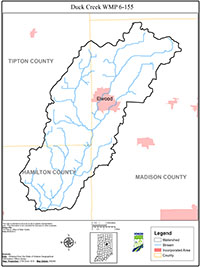Summary
The Duck Creek Watershed Management Plan (WMP) is the result of the combined efforts of the Hamilton, Tipton, and Madison County Soil and Water Conservation District offices, the Hamilton County Surveyor’s Office, the IN Farm Bureau, IDEM, local farmers, residents, and landowners. This group met throughout the planning phase to discuss social issues, identify public outreach topics, define water quality issues and their potential sources, and prioritize and develop management goals.
The Duck Creek Watershed collects runoff from approximately 105 square miles of north-central Indiana. It is a part of the Upper White River Sub-Basin and drains predominantly through agricultural areas within Hamilton, Madison, and Tipton counties.
Based on E. Coli and biotic community studies, the IDEM has listed Duck Creek and all of its major tributaries on their list of impaired water bodies. In response, the Hamilton County Soil and Water Conservation District (HCSWCD) applied for and received a federal grant through the state to create this WMP.
With this grant, the HCSWCD formed a steering committee made up of government personnel, professional consultants, local farmers, residents, and landowners with the mission to provide leadership, education, and coordination to identify water quality needs and concerns within the watershed, and to develop a comprehensive and feasible management plan to address those needs and promote an improved watershed health. Based on steering committee input and IDEM WMP guidance, this plan addresses nonpoint sources of pollution by summarizing readily available water quality data, collecting supplemental data, identifying and prioritizing critical areas, and proposing possible locations for best management practices capable of improving water quality.
Through these efforts, the Duck Creek Watershed steering committee hopes to achieve the vision of a healthy watershed in which all land uses are both economically feasible and ecologically responsible to ensure improved and sustainable water quality for present and future generations. In order to achieve this vision, the following goals have been developed by the steering committee.
- Goal 1: Reduce TSS loads in the Duck Creek Watershed.
- Goal 2: Reduce E. coli loads in the Duck Creek.
- Goal 3: Reduce Nitrogen loads in the Duck Creek Watershed.
- Goal 4: Reduce Phosphorus loads in the Duck Creek Watershed.
- Goal 5: Create and implement water quality educational programs in the Duck Creek Watershed.
This WMP should not only serve as a reference for the implementation phase, but also as a reference for future water quality efforts in this area.

